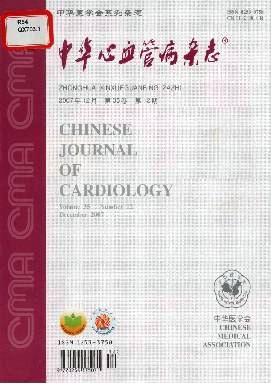[全血细胞源性炎症标志物联合NT-proBNP对慢性心力衰竭患者预后的预测价值]。
摘要
目的:评价全血细胞源性炎症标志物(包括全身免疫炎症指数(SII)、全身炎症反应指数(SIRI)、中性粒细胞计数/淋巴细胞计数(NLR)、血小板计数/淋巴细胞计数(PLR)、单核细胞计数/淋巴细胞计数(MLR))及联合n端前b型利钠肽(NT-proBNP)对慢性心力衰竭患者预后的预测价值。方法:本研究为回顾性队列研究。研究对象为2019年1月至2022年8月在南方医科大学南方医院心血管内科住院的慢性心力衰竭患者。对患者进行随访,根据随访结果分为生存组和死亡组。比较两组患者的临床特点。采用受试者工作特征(ROC)曲线确定预测慢性心力衰竭患者全因死亡的各全血细胞衍生炎症标志物的最佳临界值。绘制Kaplan-Meier生存曲线,采用log-rank检验比较不同全血细胞源性炎症标志物水平慢性心力衰竭患者的生存差异。采用单因素和多因素Cox比例风险模型分析全血细胞来源炎症标志物和NT-proBNP对慢性心力衰竭患者全因死亡的影响。采用ROC曲线分析全血细胞源性炎症标志物联合NT-proBNP对慢性心力衰竭患者预后的预测价值。结果:共纳入324例(64.76±13.78)岁心力衰竭患者,其中男性212例(65.43%)。297例(91.67%)患者完成随访,27例(8.33%)患者失访。随访时间24.0(18.0,41.8)个月。生存组258例,死亡组66例。ROC曲线测定SII、SIRI、NLR、PLR和MLR的最佳临界值分别为739.83、1.65、3.14、151.95和0.37。Kaplan-Meier生存曲线分析显示,SII(≥739.83)、SIRI(≥1.65)、NLR(≥3.14)、PLR(≥151.95)、MLR(≥0.37)水平较高的慢性心力衰竭患者的全因死亡发生率高于炎症标志物水平较低的患者(全部PHR=1.04, 95%CI 1.01 ~ 1.06, P=0.002)、NT-proBNP (HR=2.93, 95%CI 1.64 ~ 5.23, PHR=3.27, 95%CI 1.18 ~ 9.02, P=0.022)和PLR≥151.95 (HR=2.67, 95%CI 1.02 ~ 6.96)。P=0.045)是慢性心力衰竭患者全因死亡的独立预测因子。ROC曲线分析显示,SII、PLR联合NT-proBNP (AUC=0.850)对慢性心力衰竭患者预后的预测价值优于SII (AUC=0.779)、PLR (AUC=0.782)、NT-proBNP (AUC=0.727)和CRP (AUC=0.668)(均为p)。结论:全血源性炎症标志物SII、PLR和NT-proBNP与慢性心力衰竭患者全因死亡独立相关。SII、PLR可独立预测慢性心力衰竭患者的预后,SII、PLR联合NT-pro BNP对慢性心力衰竭患者的预后有较好的预测价值。Objective: To evaluate the predictive value of whole blood cell derived inflammatory marker (including systemic immunoinflammatory index (SII), systemic inflammatory response index (SIRI), neutrophil count/lymphocyte count (NLR), platelet count/lymphocyte count (PLR), and monocyte count/lymphocyte count (MLR)) and in combination with N-terminal pro-B-type natriuretic peptide (NT-proBNP) on the prognosis of patients with chronic heart failure. Methods: This study was a retrospective cohort study. Patients with chronic heart failure hospitalized in the Department of Cardiovascular Medicine, Nanfang Hospital, Southern Medical University from January 2019 to August 2022 were enrolled. Patients were followed up and were divided into survival group and death group according to the follow-up results. Clinical characteristics of the two groups were compared. Receiver operating characteristic (ROC) curve was used to determine the optimal cut-off value of each whole blood cell derived inflammatory marker for predicting all-cause death in patients with chronic heart failure. Kaplan-Meier survival curve was drawn, and log-rank test was used to compare the difference in survival of chronic heart failure patients with different levels of whole blood cell derived inflammatory markers. Univariate and multivariate Cox proportional hazards models were used to analyze the effects of whole blood cell derived inflammatory markers and NT-proBNP on the all-cause death of patients with chronic heart failure. ROC curve was used to analyze the predictive value of whole blood cell derived inflammatory markers combined with NT-proBNP on the prognosis of patients with chronic heart failure. Results: A total of 324 patients with heart failure aged (64.76±13.78) years were enrolled, with 212 males (65.43%). 297 patients (91.67%) completed follow-up, 27 patients (8.33%) were lost to follow-up. The follow-up time was 24.0 (18.0, 41.8) months. There were 258 patients in the survival group and 66 patients in the death group. The optimal cut-off values of SII, SIRI, NLR, PLR and MLR determined by ROC curve were 739.83, 1.65, 3.14, 151.95 and 0.37, respectively. Kaplan-Meier survival curve analysis showed that patients with chronic heart failure with high levels of SII (≥739.83), SIRI (≥1.65), NLR (≥3.14), PLR (≥151.95) and MLR (≥0.37) had higher incidence of all-cause death than patients with low levels of inflammatory markers (all P<0.001). Multivariate Cox proportional hazard regression analysis showed that age (HR=1.04, 95%CI 1.01-1.06, P=0.002), NT-proBNP (HR=2.93, 95%CI 1.64-5.23, P<0.001), SII≥739.83 (HR=3.27, 95%CI 1.18-9.02, P=0.022) and PLR≥151.95 (HR=2.67, 95%CI 1.02-6.96, P=0.045) were independent predictors of all-cause death in patients with chronic heart failure. ROC curve analysis showed that the predictive value of SII and PLR combined with NT-proBNP (AUC=0.850) for the prognosis of patients with chronic heart failure was better than that of SII (AUC=0.779)、PLR (AUC=0.782)、NT-proBNP (AUC=0.727) and CRP (AUC=0.668) alone (all P<0.001). Conclusions: Whole blood cell derived inflammatory markers--SII, PLR, and NT-pro BNP were independently associated with all-cause death in patients with chronic heart failure. SII and PLR can independently predict the prognosis of patients with chronic heart failure, combination of SII and PLR with NT-pro BNP has better predictive value for the prognosis of patients with chronic heart failure.

 求助内容:
求助内容: 应助结果提醒方式:
应助结果提醒方式:


